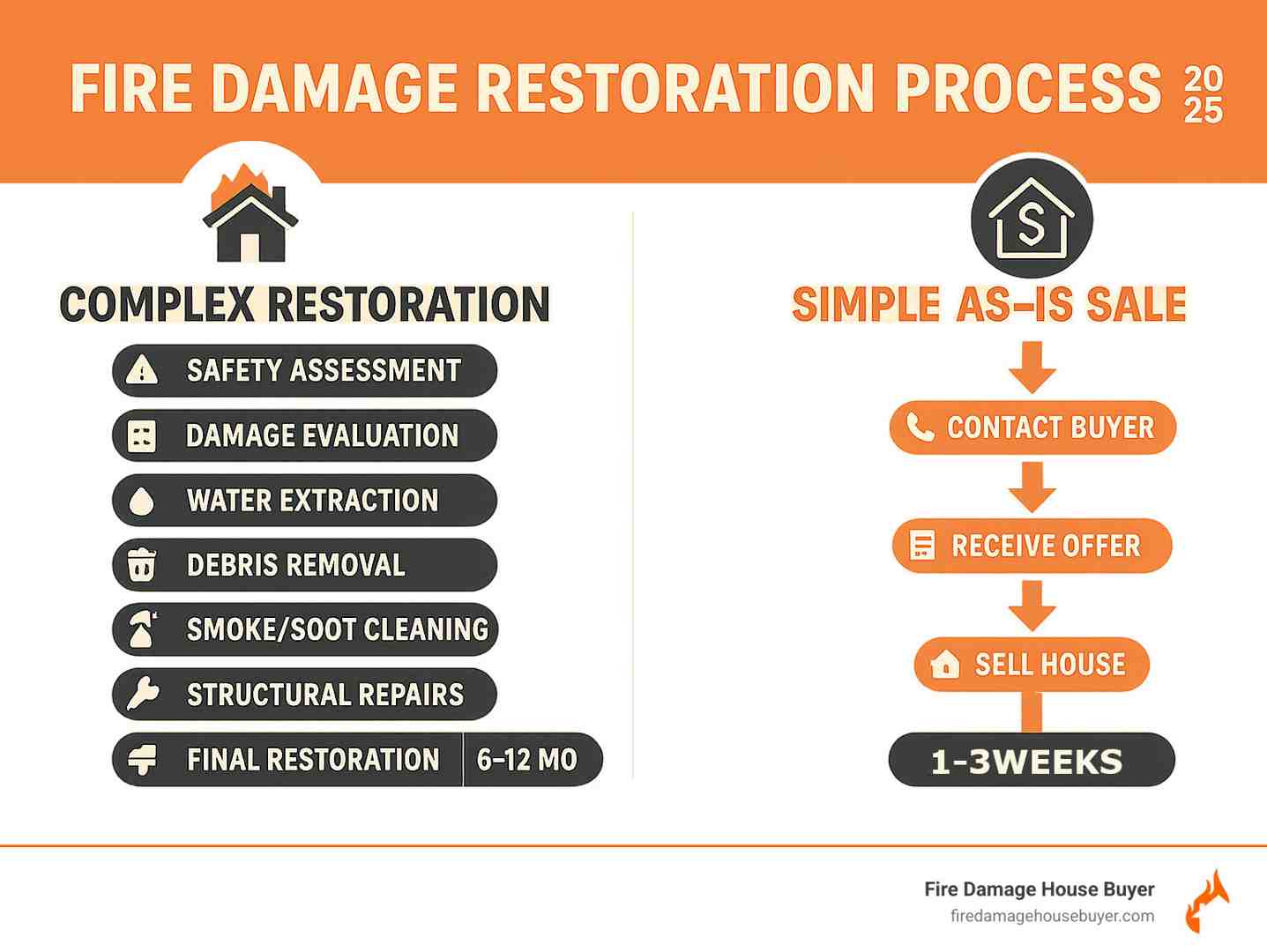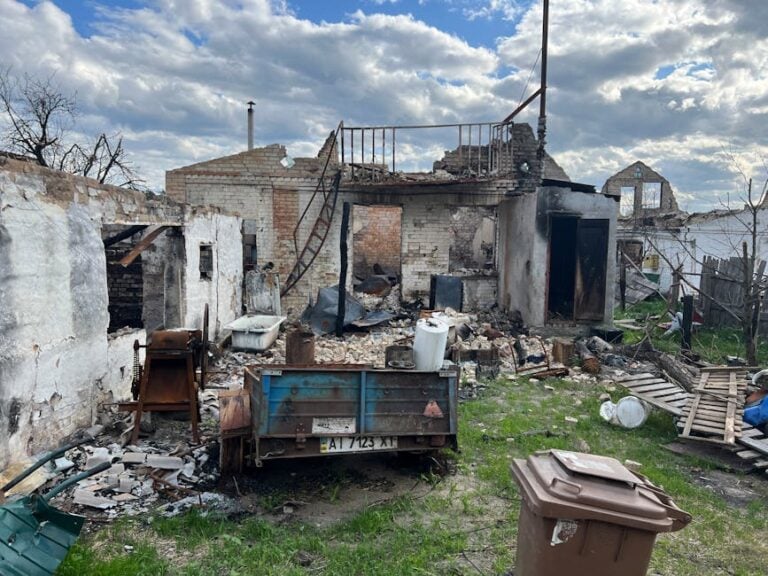Why Understanding Fire Damage Restoration Matters for Your Recovery
To restore a house with major fire damage involves a complex, multiphase process that normally can take 6-12 months and cost anywhere from $50,000 to over $200,000 depending on the extent of damage. Here’s what the restoration process entails:
Essential Steps for Fire Damage Restoration:
- Safety assessment – Professional inspection before entry
- Damage evaluation – Structural, smoke, water, and electrical assessment
- Water extraction – Remove firefighting water within 48-72 hours
- Debris removal – Clear damaged materials and secure property
- Smoke/soot cleaning – Specialized cleaning and odor removal
- Structural repairs – Rebuild damaged walls, floors, and systems
- Final restoration – Paint, flooring, and finishing work
Finding your house damaged by fire is a nightmare scenario that over 350,000 American families face each year. The devastation goes beyond what you can see – smoke damage penetrates every surface, water from firefighting efforts can cause mold within days, and structural damage may lurk beneath seemingly intact walls.
You’re facing two paths forward: undertake a lengthy, expensive restoration process or explore a simpler alternative. While this guide provides a comprehensive checklist for those considering restoration, it’s important to understand that selling your fire-damaged house as-is for cash often proves to be the more practical solution for most families.
The restoration process is overwhelming, time-consuming, and frequently costs more than expected. Between permits, code upgrades, temporary housing, and hidden damage findies, many homeowners find themselves months into a project that exceeds their insurance coverage and emotional capacity.
As Daniel Cabrera, founder of Fire Damage House Buyer with over 16 years of experience helping homeowners steer fire damage situations, I’ve guided families through understanding how to restore house with major fire damage while also showing them simpler alternatives. Having personally bought and sold over 275 distressed properties, I understand that sometimes the best path forward isn’t always the most obvious one.

The First 48 Hours: Immediate Safety and Damage Assessment

The first 48 hours after a house fire are a whirlwind. While your first instinct may be to rush inside to see what’s left, safety absolutely must come first.
Do not re-enter your property until fire authorities give you the official all-clear. Even after the flames are out, your home can hide dangerous surprises. We’re talking about compromised electrical systems that could spark, weakened structural elements that might collapse, and toxic fumes from burned materials that can seriously harm your health.
Once everyone is safe, your next critical step is contacting your insurance agent immediately. Don’t wait—call them right away to start the claims process. This early action can make a huge difference in your recovery.
Now comes securing your property, which is where understanding how to restore house with major fire damage begins. You’ll need professional board-up services to cover broken windows and doors and potentially install temporary fencing. This isn’t just to keep people out; it prevents rain, wind, and debris from causing more damage.
Your insurance company will likely require this protection. Water damage from a storm can add thousands to your restoration costs, making an already expensive situation overwhelming.
Once it’s safe to approach your property, start your initial documentation with photos and videos from every possible angle. Capture the exterior damage and document everything you see. This visual evidence is crucial for your insurance claim and helps you understand the full scope of what you’re facing.
For a comprehensive list of what to document, check out our detailed Checklist for Fire Damage. Every photo you take now could save you time and money later—or help you realize that restoration might not be the most practical path.
The reality is that many homeowners, after seeing the full extent of damage, question whether restoration is worth the stress and expense. Sometimes the smartest decision is to Sell Fire Damaged House as-is and move forward with your life rather than spending months navigating the complex restoration process.
Understanding the Full Scope: What to Look For
When you’re trying to figure out how to restore house with major fire damage, it’s easy to focus on the obvious charred walls and burned furniture. But here’s the thing – what you can see is often just the beginning of your problems.
Fire damage comes in layers, and each one brings its own headaches. Primary damage is what most people notice first – the actual flame damage that charred your kitchen cabinets or burned through your roof. It’s heartbreaking to see, but at least it’s obvious.
Then there’s secondary damage, which is honestly where things get tricky. Smoke and soot don’t respect boundaries. They sneak into every crack, crevice, and hiding spot in your home. That acrid smell? It’s not just unpleasant – it’s smoke particles that have embedded themselves into your walls, your belongings, and even areas the fire never touched.
The water damage from firefighting efforts adds another layer of complexity. While we’re grateful firefighters saved what they could, all that water has to go somewhere. It seeps into floors, soaks insulation, and creates the perfect breeding ground for mold. If you don’t address this within 48-72 hours, you’re looking at a whole new set of problems.
But here’s where it gets really concerning – the hidden damage you can’t see. Heat does terrible things to the bones of your house. Your electrical systems might look fine on the surface, but wire insulation could be melted inside your walls. Plumbing pipes can warp or develop weak joints that’ll fail weeks later. Your HVAC ducts? They’ve likely become highways for spreading soot and smoke throughout your entire home.
This is exactly why you need a structural engineer for any significant fire damage. They’re trained to spot the dangerous stuff you might miss – foundation cracks from extreme temperature changes, warped framing that’s no longer safe, or load-bearing walls that have been compromised. Trying to assess this yourself isn’t just ineffective; it can be downright dangerous.
Then comes the heartbreaking part – assessing your personal belongings. Some items might be salvageable with professional cleaning, while others are simply too damaged or contaminated to save safely. Hard surfaces like metal and glass often fare better than porous materials like mattresses, upholstered furniture, or books.
The reality is, understanding the full scope of fire damage often reveals why restoration becomes such an overwhelming process. Between structural concerns, hidden damage, and the complexity of proper cleanup, many homeowners find themselves facing months of work and costs that quickly spiral beyond their insurance coverage.
If you’re feeling overwhelmed by the scope of damage you’re finding, you’re not alone. For more detailed guidance on the restoration process, check out our house fire damage restoration guide. And for help navigating the insurance side of things, our House Fire Insurance Claim Tips can help you document everything properly.
Sometimes, after seeing the full picture, many families realize that selling their fire-damaged home as-is might be the more practical path forward.
The Restoration Process: How to Restore a House with Major Fire Damage
When you’re facing the reality of how to restore house with major fire damage, you’re looking at one of the most complex home improvement projects imaginable. This isn’t a weekend DIY project—it’s a massive undertaking that requires specialized knowledge, professional-grade equipment, and months of work.
The truth is, professional help is crucial for any significant fire damage. The complexity of restoration goes far beyond what most homeowners can handle safely, involving toxic residues, compromised structural elements, and systems that are dangerously damaged beneath the surface.
Before any work begins, you’ll need to steer the permitting process. Your local building department will require permits for demolition, structural repairs, electrical work, and more. This ensures all work adheres to current building codes, which have likely been updated since your home was built and exist to keep you safe.

Mitigating Water Damage and Debris: A Critical Step in How to Restore a House with Major Fire Damage
The water used to extinguish the fire can cause as much damage as the flames. Water extraction must happen within 24-48 hours to prevent mold. Professional teams use powerful pumps, vacuums, industrial dehumidifiers, and air movers to dry the structure completely. This is not a job for box fans. The goal is mold prevention, as a mold infestation can double or even triple your restoration costs.
Next comes debris removal—clearing out everything that can’t be saved, like charred furniture, melted belongings, and damaged drywall. During this phase, professionals will also handle tarping the roof if it’s been damaged to protect your home from further weather-related harm.
Throughout this process, safety precautions are critical. Fire residue contains harmful chemicals, and the structure may be unstable. Essential safety gear includes an N95 respirator, heavy-duty gloves, safety goggles, and sturdy boots.
Smoke, Soot, and Odor Removal
Smoke particles are microscopic and get into everything, leaving behind a sticky residue and a persistent smell. Specialized cleaning is the only way to tackle this. Professionals use soot sponges and specific chemical cleaners designed for fire residue, as regular household cleaners will only spread the soot and make it worse.
The real challenge is odor neutralization. A lingering smoke smell indicates harmful particles are still present. Professionals use treatments like thermal fogging, which vaporizes a deodorizing agent to penetrate surfaces just as the smoke did. Ozone generators are another tool used to chemically break down odor-causing molecules. Your HVAC system cleaning is also crucial, as ductwork spreads soot throughout the house. This step is vital for a successful restoration.
Rebuilding and Structural Repairs: The Final Phase of How to Restore a House with Major Fire Damage
After months of cleanup, you finally get to the rebuilding phase, where costs really add up. Replacing drywall, installing new flooring, and applying fresh painting to seal any remaining particles are just the beginning.
Repairing structural elements might mean anything from minor framing repairs to completely rebuilding entire sections of your home. An electrical system overhaul is almost always necessary, as heat and water compromise wiring. Similarly, plumbing repairs address pipes and fixtures damaged by extreme temperatures.
Many homeowners use this opportunity for energy efficiency upgrades—better insulation, modern windows, and updated HVAC systems. If you’re in a disaster-prone area, you might also consider fire-resistant materials.
But here’s the reality check: by the time you factor in all these phases, you’re looking at 6-12 months of work and costs that often range from $50,000 to well over $200,000. Many families find the financial and emotional toll far exceeds what they initially expected.
That’s why many homeowners choose to Sell Fire Damaged House as-is instead. It eliminates the stress, uncertainty, and massive costs of restoration, allowing families to move forward with their lives.
The Reality of Rebuilding: Costs, Timelines, and The Simpler Alternative
Let’s be honest about what how to restore house with major fire damage really looks like in practice. It’s a marathon that tests your patience, wallet, and emotional resilience.
| Factor | Restoration (Complex Path) | Selling As-Is (Simple Path) |
|---|---|---|
| Timeline | 6-12 months, often longer (1-8 months minimum) | 2-3 weeks (Fast cash offer, quick closing) |
| Cost | $50,000 to $200,000+ (often exceeds insurance) | Zero out-of-pocket (we cover closing costs) |
| Stress Level | Very High (permits, contractors, insurance, hidden costs) | Very Low (no repairs, no cleaning, no showings) |
| Outcome | Restored home, but with significant personal investment | Cash in hand, freedom to move on quickly |
The restoration timeline alone is overwhelming. While minor smoke damage might take weeks, major structural repairs stretch well beyond six months, with most full restorations taking 6-12 months or more. Every delay—permits, contractors, weather—compounds the stress.
Then there’s the financial reality. Minor fires might cost $3,500 to $5,000 to restore. But major structural damage? That number jumps to $50,000 or more, often climbing past $100,000 or even $200,000.
What catches most homeowners off guard are the hidden costs. Permit fees can run into the thousands. Code upgrades are often mandatory for electrical and plumbing systems when doing substantial work, adding unexpected expenses.
Temporary housing becomes a major expense. While insurance covers some additional living expenses, it has limits, and many families find themselves paying out of pocket for extended stays while still paying a mortgage on an uninhabitable house.
You also have to account for storage fees, debris removal costs, and the inevitable unforeseen issues found once walls are opened. It’s wise to budget an extra 10-15% of your insurance payout for these surprises.
The emotional toll might be the hardest part. You’re already dealing with trauma, and now you’re facing months of decision fatigue—choosing contractors, selecting materials, and navigating insurance disputes. The stress and anxiety compound with each delay and unexpected cost.
After a fire damage claim, your insurance premiums will likely increase for years. Even with safety upgrades, you’re looking at higher long-term costs.
This is why many smart homeowners choose a simpler path. Instead of wrestling with how to restore house with major fire damage, they’re finding relief by selling their fire-damaged house as-is for cash.
When you Sell Fire Damaged House to us, there are no repairs needed. There are no commissions, and you can expect a fast cash sale that closes in weeks, not months. It’s a stress-free solution that lets you move forward with your life.
Frequently Asked Questions about Major Fire Damage Restoration
We know you’re dealing with an overwhelming situation, and it’s natural to have questions. After helping hundreds of families, these are the questions we hear most often:
How much does it cost to restore a house after a major fire?
The cost to restore a house after a major fire varies dramatically, but it’s almost always higher than homeowners expect. For smaller fires, you might be looking at $3,500 to $5,000. But for major structural damage, costs easily jump to $50,000 or more, with complete restorations reaching $200,000 or beyond.
The heartbreaking truth is that these costs often exceed insurance coverage. Hidden expenses like debris removal, permit fees, code upgrades, and temporary housing add up quickly. Many families find themselves tens of thousands of dollars short, which is why selling as-is often makes more financial sense.
Can I do the fire damage cleanup myself?
We understand the urge to do the work yourself, but for major fire damage, we strongly encourage you to let professionals handle it. Major fire damage cleanup isn’t recommended as a DIY project for several serious reasons:
- Health Risks: Fire residue contains toxic chemicals that pose significant health risks, causing respiratory problems and skin irritation. Even if you can’t smell it, harmful particles are still present.
- Structural Dangers: Fire weakens building materials in ways that aren’t always visible. What looks stable might not be, putting you at risk.
- Ineffective Cleaning: Improper techniques can make things worse by spreading soot, driving odors deeper into materials, and ruining salvageable items.
Professional restoration teams have the specialized equipment, solutions, and training to do this work safely and effectively. It’s not an area where cutting corners makes sense.
How can I prevent future house fires?
Once you’ve been through a house fire, preventing another one becomes a top priority. There are proven steps that significantly reduce your risk.
Installing and maintaining smoke detectors is your first line of defense. Have them on every level, inside bedrooms, and outside sleeping areas. Test them monthly and consider interconnected detectors so when one sounds, they all do.
Electrical system maintenance is crucial. Have a licensed electrician inspect your wiring, avoid overloading outlets, and use quality surge protectors.
Your dryer vent cleaning routine matters. Clean the lint filter after every load and have the entire vent system professionally cleaned annually.
Kitchen safety practices can prevent the most common type of house fire. Never leave cooking unattended and keep a fire extinguisher within easy reach.
If you’re in a wildfire-prone area, creating defensible space by clearing vegetation from your home’s perimeter is essential. When rebuilding, consider fire-resistant materials.
For more detailed prevention strategies, check out our resources section where we share practical tips for protecting your home.
The reality is that even with all these precautions, fires can still happen. That’s why many of our clients choose to sell their fire-damaged property as-is rather than face the stress and expense of restoration. It’s a practical decision that lets them move forward.
Conclusion: Your Path to Recovery After a House Fire

We’ve covered a lot of ground together in this guide on how to restore house with major fire damage. From those critical first 48 hours when safety is everything, to understanding the hidden damage lurking behind walls, to the months-long journey of water mitigation, smoke removal, and rebuilding – it’s honestly overwhelming when you see it all laid out.
The restoration path is possible, but it’s not easy. You’re looking at 6-12 months of your life, costs that often exceed $50,000 to $200,000, and the constant stress of managing contractors, permits, and insurance adjusters. Even with our detailed house fire damage restoration guide, the reality is that most families find themselves emotionally and financially drained by the process.
That’s exactly why we started Fire Damage House Buyer. We’ve seen too many families struggle through restoration only to wish they had taken a different path. When Daniel Cabrera founded our company after helping over 275 families steer fire damage situations, he realized that sometimes the best solution isn’t the most obvious one.
Here’s what makes our approach different: we buy houses as-is, which means you don’t lift a finger. No cleaning soot off walls, no dealing with water damage, no endless contractor meetings. We handle everything and offer you a fast cash offer with no commissions and no hidden fees. Most families close within 2-3 weeks and walk away with cash in hand, ready to start fresh.
Think about it this way – instead of spending the next year of your life managing a restoration project that might cost more than your insurance covers, you could be settled in a new home next month. Instead of dealing with the stress and uncertainty of rebuilding, you could have peace of mind and a fresh start.
You’ve been through enough trauma with the fire itself. You deserve a solution that’s simple, straightforward, and stress-free. That’s exactly what we provide when you sell a fire damaged house to us.
Ready to explore this simpler path? Get your no-obligation cash offer today and find how we can help you move forward without the headaches of restoration. Sometimes the best way to rebuild your life is to start somewhere new.


